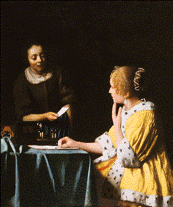
THANK YOU FOR YOUR VISIT...
NOW SCRAM!
NOW SCRAM!
by Richard Ledes

Photocredit © Digital Collections
Great Paintings--Renaissance to Impressionism:
The Frick Collection, CD-ROM
by Digital Collections Inc.
$79.95
1 800 449 6220
The Uffizi Gallery
http://www.televisual.it/uffizi/
The Louvre Museum
http://mistral.culture.fr/louvre/
|
Closing time at museums can be frustrating, representing an inopportune encounter between an individual's desire for an escape from profane time with an institution's need for punctuality. CD-ROMs and a Web connection might raise the hope that we never need worry again about having this experience. In a manner of speaking, we would own a key to the museum, and to the knowledge of its curators. We recently looked at one museum's CD-ROM and two museums online to see how close we might already be to this utopia. The Uffizi Gallery in Florence, the musee du Louvre in Paris, and the Frick Collection in New York were the museums we chose for comparison. The results were surprising. Our highest hopes rested with the CD-ROM Great Paintings--Renaissance to Impressionism: The Frick Collection. Whereas bandwidth would be an impediment for the museums on the Web, the CD-ROM might instantly provide high-quality reproductions and oodles of information. Unfortunately, the present version of this CD-ROM--while impressive--only partially lives up to these expectations. Most of the great paintings in the Frick Collection are represented here; the indexing system allows you to find them quickly, and close-ups of details are provided for certain of the works. The user can enjoy that Blade-Runner feeling, by zooming in on, for example, a detail of Vermeer's "Mistress and Maid" (1665-1670). One problem, however, is that the larger image of each painting supports very little magnification; there are pre-selected details on which viewers can zoom in, but this pre-selection means that their choices are more limited than they might want. Nevertheless, this CD-ROM allows the user to view and compare great works of art with extraordinary ease; it constitutes a way of appreciating these works that validates their digital translation. A more serious shortcoming than the need to switch to pre-selected details is a paucity of accompanying multimedia material--no audio tour of the collection, for example. Additionally, the textual resources are very limited. No secondary critical articles are available. You can search the bare-bone texts looking, for example, for uses of the term "allegory." Each use of the term is then indexed, but nowhere is there even a tenuous attempt to explain what allegory or its importance in art might be. To imagine how disappointing all this is, it is only necessary to imagine this material in the form of a book. Using Web resources in conjunction with this CD-ROM might help, but the CD-ROM provides no information on related URLs. Let's hope that the coming introduction of DVD technology will provide DCI with an opportunity to rework this excellent start to a CD-ROM into the really fine product it could be. The website of the Uffizi Gallery has been improving by leaps and bounds. This improvement has mainly consisted of expanding hypertexts, combining information about artists, their paintings, and particular periods in the history of art. For instance, the text on Botticelli contains a link to information on his teacher Filippo Lippi. A glossary is provided for important terms; clicking on "Byzantine Art," we learn that Cimbaue recognized the talent of Giotto when he saw Giotto painting the image of a sheep on a rock. A visitor can view such famous paintings as Botticelli's "Allegory of Spring" (1477-78) or his "Birth of Venus" (1483). Large reproductions of these paintings can be downloaded, but then the limitations begin to appear. To zoom in on particular portions of the painting, the images will need to be opened in a program such as "Adobe Photoshop," and, even then, the image has the typical drawback of all such Web-derived reproductions; the quality is inadequate to support much zooming: in this case, very little Blade-Runner feeling. The site features no links to secondary texts, and only a limited selection of the museum's holdings are on view. Nevertheless, this is a museum site that appears to be reinventing itself in pleasing ways all the time. In the past, there have been two--possibly three--Louvres on the Web. What became popularly known as Le WebLouvre is now known as the WebMuseum--a collection of links to museums worldwide, maintained by Nicolas Pioch. The musee du Louvre (http://mistral.culture.fr/louvre/) has an immediate drawback for anyone who doesn't speak French: it's only in French. This is really inexcusable given the size and obvious resources of this state-sponsored institution, but is connected to a bigger set of issues in France, concerning the preservation of the French language; in the meantime, non-French Web visitors are going to have to get around using images. These images are of the same quality as those found at the Uffizi site-- again, no Blade-Runner thrills. The selection is limited but strong-- a shortcut to the Mona Lisa (1503-1506) is provided. For the French speaker the site does include a magazine--the only place at any of the three sites mentioned here that contains secondary information. The magazine contains part of an extremely prescient article about art in the future, written by the French poet Paul Valery in 1928. No glossary is offered in any language. The most effective aspect of this site is the way it informs Parisians about activities taking place at the museum; this is not a feature, however, that is much use to someone visiting the site from farther away. All in all, making the contents of museums available through the use of interactive media and technology retains signs of still being in its early stages; one of the most salient features to emerge from this comparison is how differently the "content" of museums can be defined, and how much more could be done to utilize multimedia's ability to provide different contexts... Closing time. |
© Richard Ledes 1996